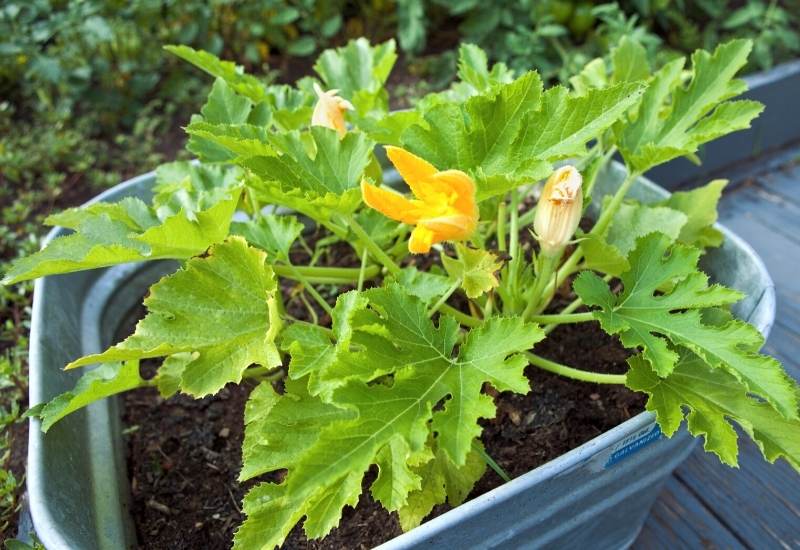
Yes, growing zucchini in pots is really possible! Many people assume that they can’t grow zucchini because, like other squash varieties, the vines like to spread out.
In fact, zucchini is a great veggie to grow for container gardening and small-space gardens.
Growing zucchini is a great idea! They’re known for being one of the most prolific summer veggies, producing a harvest for weeks.
They’re so bountiful that you might need to give some of your zucchini away to the neighbors!
The other great thing about zucchini plants is that they’re so easy to grow.
You probably assumed that, due to their large size, zucchini plants would be hard to grow in containers.
That assumption would be wrong! Zucchini plants love to grow in pots, and you’ll still end up with a bountiful harvest.
This guide is designed to show you all about growing zucchini in pots. From picking the right container to learning how to plant zucchini seeds properly, let’s get started learning how to grow zucchini in containers.
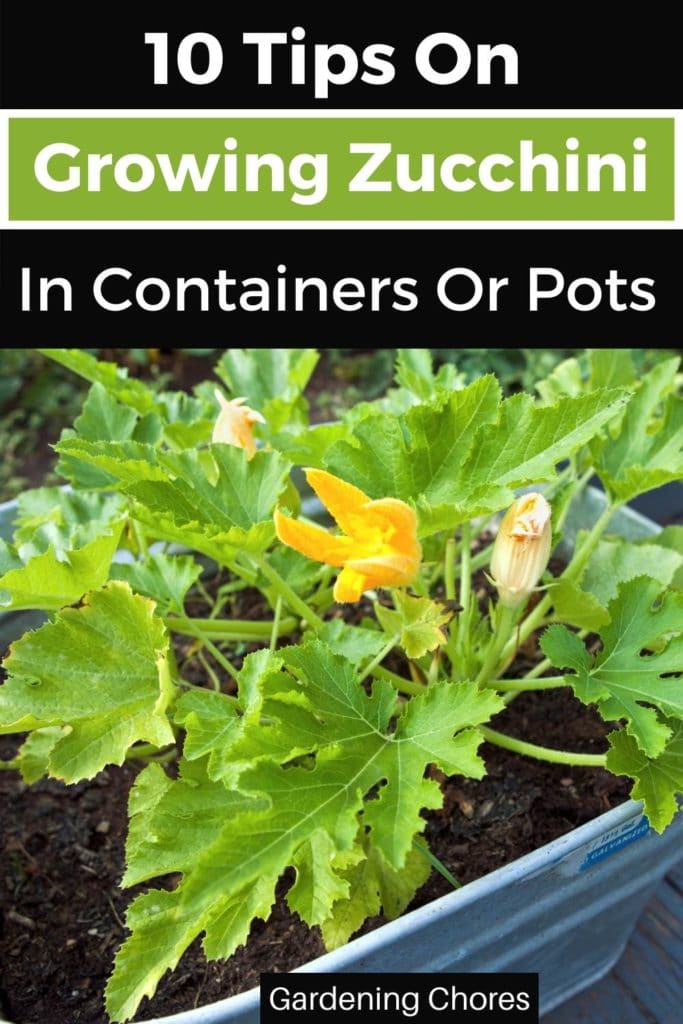
How to Start Growing Zucchini in Containers
It’s true that zucchini plants sprawl out and take p space, but you’ll see that growing zucchini in pots is easy.
These plants thrive in pots, so let’s take a look at how to grow them in containers.
1. Choose A Large Container Container With Drainage Holes
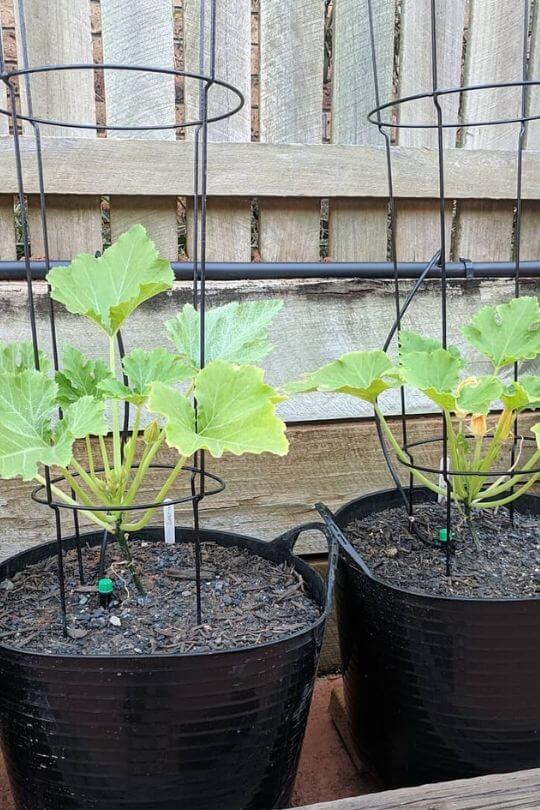
Despite their large size, zucchini plants have shallow roots. It’s more important to have wide containers to stop the vines from touching the ground than to have a deep container.
For growing zucchini pick a large container that is 12 inches deep and 12 inches across. Any pot will work so long as it has at least one or two suitable drainage holes in the bottom.
You can use a plastic storage container with drainage holes you create with a drill. A half whiskey barrel can be a great choice if you want to grow more than one zucchini plant.
Plastic pots are cheaper and lightweight, but they are non-porous and might lead to waterlogged soil. Look for terra cotta pots because they’re porous and attractive, a good balance.
2. Place Your zucchini Pots In Full Sun
When you’re growing in containers, you can move your pots wherever you need them to get the best sunlight.
Zucchini plants need six hours or more of sunlight each day for optimal growth. Try to find the place in your yard or patio that receives the most sunlight possible to put them.
3.Fill The Containers With Well-Draining Potting Media
Whatever you do, please don’t use dirt from your yard in your container. Garden soil is dense, and it can contain microbes, seeds, bugs, and fungi. All of those can damage your plants.
Instead, make sure you use a lightweight, well-draining potting soil. Commercial mixes are a great choice because they contain a mixture of peat moss, compost, perlite, vermiculite, or fine bark. You also can make a DIY potting soil mixture.
If the mix doesn’t contain compost, be sure to add some yourself. You also can mix a balanced fertilizer into the soil to help feed the plant.
4. Plant Zucchini Seeds 2-3 Weeks After The Final Frost
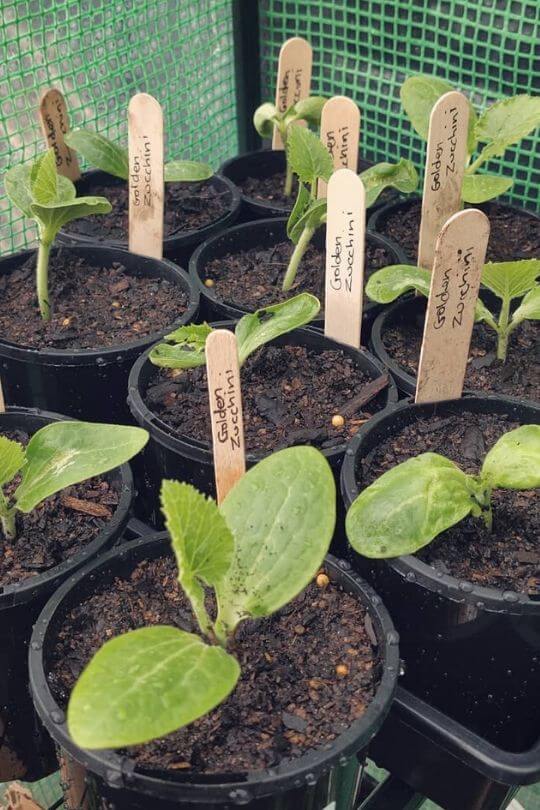
Zucchinis are NOT frost-friendly, so you need to be sure to plant the seeds or seedlings when the soil temperatures are warm. The temperatures should be between 70-85°F.
Typically, the best time to plant zucchini seeds in pot is 2-3 weeks after the final frost date in your area.
5. Planting Zucchini In Pots
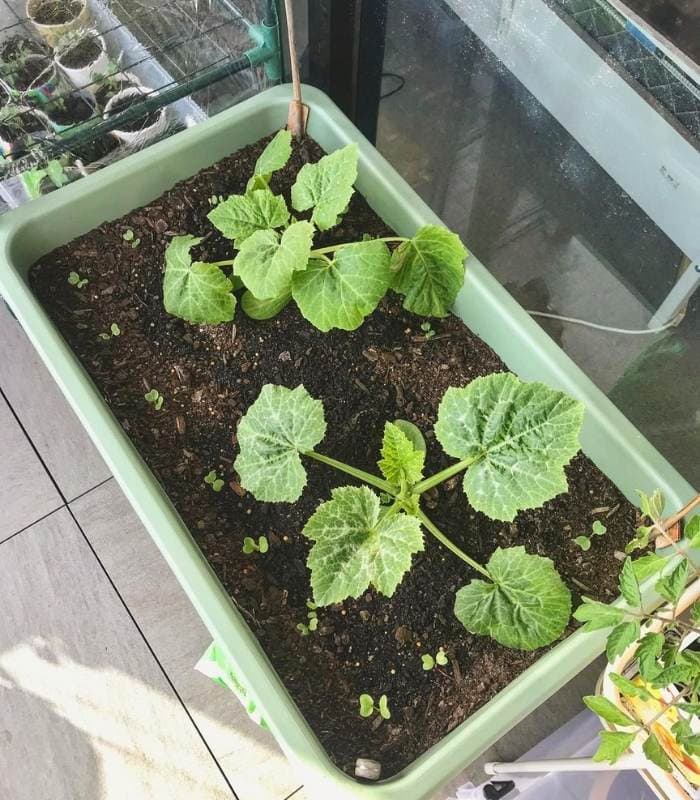
You can either grow zucchini from seeds or seedlings. If you do grow from seedlings, be sure that they are not in pots for longer than 2-3 weeks to avoid transplant shock.
When planting from seeds, make a hole that is one inch deep, and put the seed inside, and gently cover it with soil. It takes 7-10 days for zucchini seeds to germinate.
When you’re planting seedlings, the hole needs to be larger, typically 2-3 inches deep. Then loosen up the roots gently, but this is necessary to get the roots to establish in the garden beds. Then, place the seedling into the hole, cover back with soil, and pat down gently.
Zucchini like to sprawl, so containers can only hold one plant per container. Plant two seeds in each hole to ensure you have one that germinates. Then, thin out the seedlings when they’re a few inches tall.
6. Water Your Zucchini Plant Daily
Chances are you’ll need to water your plants daily. Put your fingers into the soil before watering.
If it’s damp or wet two inches below the surface, you can wait until the next day to water plants. If the soil is dry, then it’s time to water the plant gently.
When you water zucchini, make sure you gently water at the base of the plant rather than get water on the leaves.
Zucchini is vulnerable to powdery mildew, which can destroy your plants, so keep the water off of your leaves much as possible.
If you have a scorching day and your leaves start to wilt, don’t panic. Plants let their leaves wilt on sweltering days as a way to conserve water. Make sure the soil stays moist, and your plant should bounce back.
7. Mulch Around Your Plants
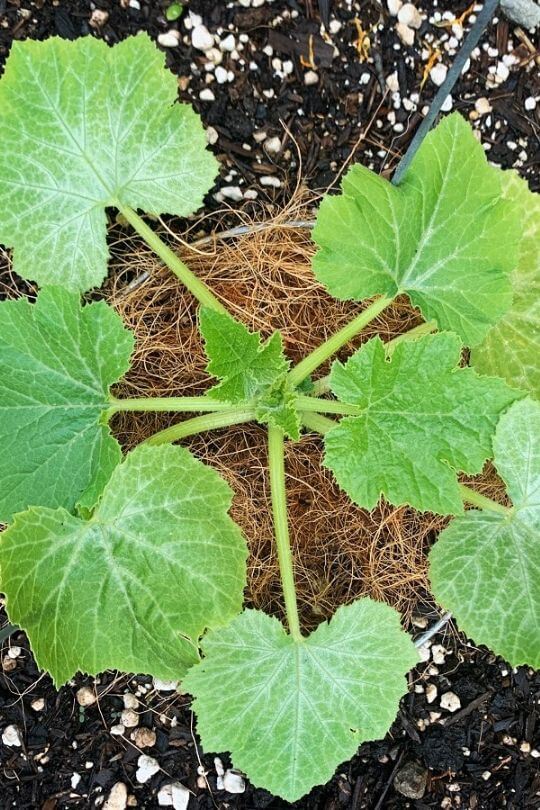
When you’re growing in containers, the soil dries out faster than it does for in-ground or raised bed gardening.
To help conserve moisture in the soil, mulching around the plants can help slow the evaporation process.
8. Feed Your Zucchini With Balanced Fertilizer Once A Month
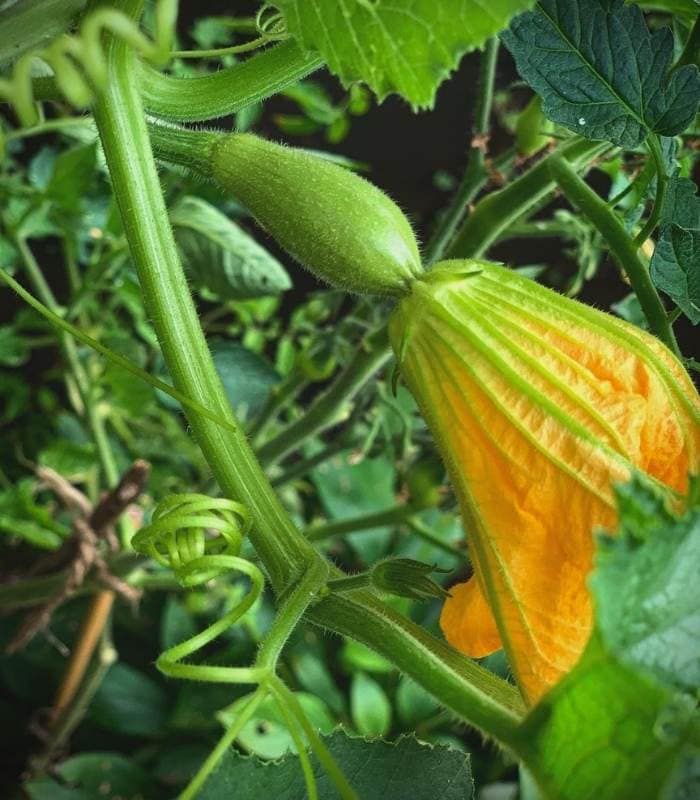
Squash plants all tend to be heavy feeders because they sprawl and overgrow. It’s best to feed your zucchini plants every four weeks.
A balanced, water-soluble fertilizer is a good choice, or use you can add a time-release fertilizer into the potting mix.
A general fertilizer that is 10-10-10 NPK works best because it contains nitrogen, potassium, and phosphorous. All of these together stimulate flowering and fruit production.
9. Hand Pollinate Zucchini Flowers To Prevent End Rot & Increase Yields
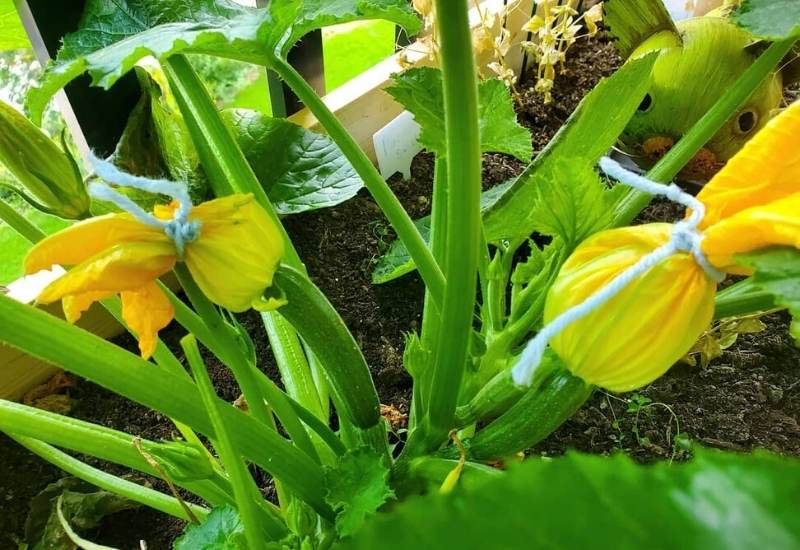
Something that you have to understand is that zucchini plants need pollinators. You need to have pollinators, or the fruits on your plants will never develop.
Try planting alyssum or borage near your zucchinis if you don’t see bees near your plants.
There is a chance you’ll need to hand pollinate your zucchini. It’s not as hard as you might think. Zucchini plants have male and female flowers.
At the bottom of the female flowers, there is a bulbous, called an ovary, that turns into your zucchini. Male flowers simply have a long stem.
To hand pollinate, take a cotton swab (or Q-tip) and swirl it around inside the male blossom.
Make sure you see pollen on the swab when you remove it out of the flower. Then, take that cotton swab and gently swirl it around inside of the female blossom.
You just played the birds and the bees in your garden!
10: Identify and Control Common Pests & Diseases That Bother Zucchini Plants
Unfortunately, zucchini plants attract an abundance of pests who want to eat the plants and fruits. Most of these pests can be controlled with natural methods.
Squash Bugs
One of the most common pests is squash bugs. They eat zucchini, winter squash, cucumber, and pumpkins.
Squash bugs lay little eggs on the underside of leaves. Make sure to squish them if you find the eggs!
Neem oil is the best way to control squash bug, or you can use an insecticidal soap. However, these sprays don’t kill the insects; all they do is stop the bugs from reproducing.
Vine Borers
These are some of the most frustrating pests to deal with in the garden. Vine borers live in the soil throughout the winter, laying eggs at the base of the stem. Then, they hatch, eating holes into your little seedlings. Then, those seedlings die.
Thankfully, if you’re using new soil for your containers, you shouldn’t have a problem with these pests.
Cucumber Beetles
These little pests are deceiving because they look sort-of like ladybugs, but they’re yellow and black instead of red and black.
Cucumber beetles do spread disease, so if you notice these little unwelcomed visitors, you need to get rid of them. One way to do that is by using spinosad, which is a soilborne bacterium.
Powdery Mildew
Here is a fungus that quickly infects plants, typically towards the end of the growing season. It’s easy to notice because it looks as if your plants are covered in a white or grey powder.
You can treat infected plants with neem oil spray. Another choice is to use milk; yes, that’s kind of weird! Mix one cup of milk, one cup of water, and a few drops of dish soap. Then, spray your plants 1-2 times per week.
Harvest Your Zucchini When It Is 6 Inches Long
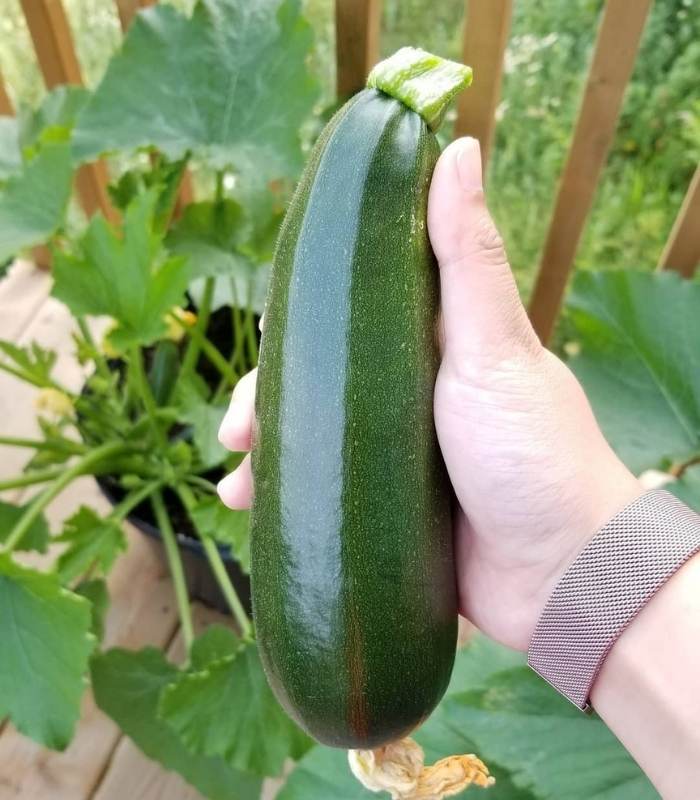
Typically, zucchini growing in containers are ready to harvest 6-7 weeks after planting. It’s better to pick when the fruits are smaller because they’re more tender and have smaller seeds.
However, it’s easy to miss them under the leaves, and you might end up with monster-sized zucchinis.
Use scissors or pruners to cut the stem of the zucchini plants. Avoid pulling the fruits off of the plant because it could pull the stems out of the ground.
Cutting the stems reduce any damage to the plants and delays mold developing on the plant.
Make sure that you harvest your zucchini plants frequently. It seems as if they go from small or average-sized fruits to the size of a baseball bat overnight. I check my plants each day.
The Best Varieties of Zucchini for Pots
When picking varieties of vegetables, including zucchini, you want to pick ones that are more compact and don’t spread out as prolifically as the other ones.
Luckily, several zucchini varieties grow exceptionally well in pots.
1. Cube Of Butter
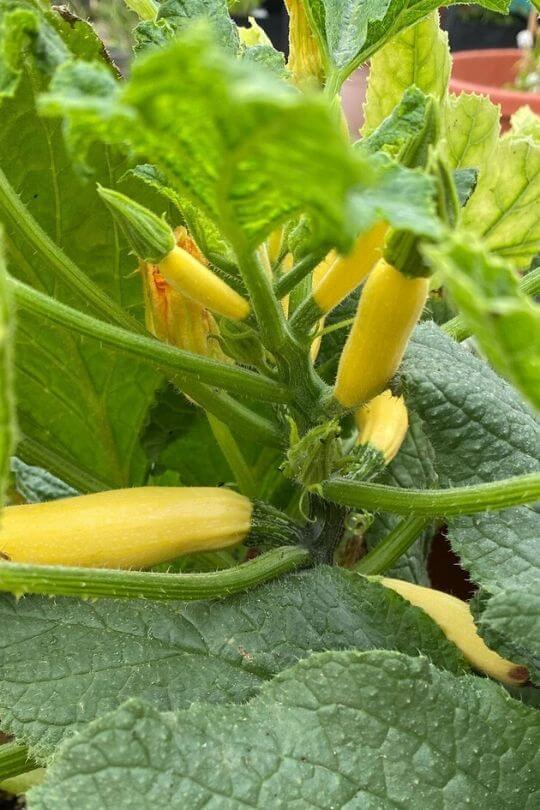
Rather than green skins, Cube of Butter has a bright, sunny, yellow rind. As the name suggests, this variety has a delicious, melt-in-your-mouth flavor.
Despite the smaller size, these plants are productive, growing a continuous harvest. You can pick the size fruits you want.
This variety does well in children’s gardens as well. Not only do the colors pop out to little kids, but since the plants are more open, they’re easier to harvest and have fewer spines on the stems.
2. Black Beauty
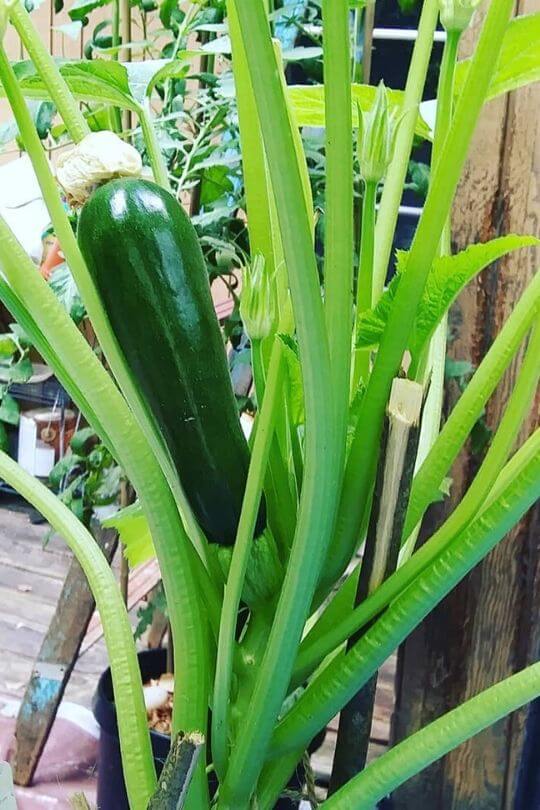
Here is an heirloom variety that is known for being highly productive with a bush-like growth pattern.
Black Beauty developed in the 1920s, and it quickly became a favorite because it has compact vines. At full maturity, the plant is 2 feet tall and 4 feet wide.
It produces dark green fruits with creamy white flesh. You’ll love how versatile this summer squash is! You can make delicious zucchini bread with it, or steam, sautee or eat it raw.
3. Jaune Et Verte Pattypan Squash
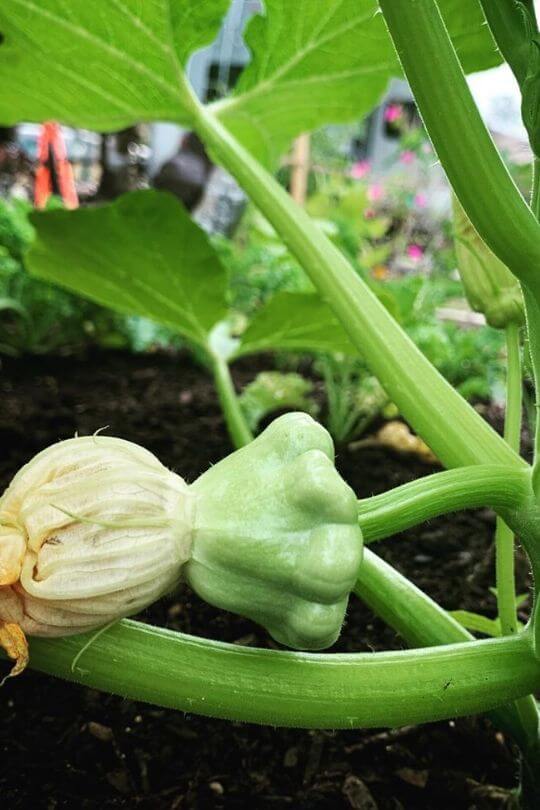
Who doesn’t want to grow a French heirloom zucchini named Pattypan? This squash has thin, delicate skin with light green fruits in a unique tulip shape. That’s right; these aren’t even shaped like ordinary zucchini!
The rind varies in shades, going from light green to yellow in radial green stripes on an ivory flesh. It’s unique and tastes fantastic. You can eat them fresh or let them mature as an ornamental squash.
4. Emerald Delight
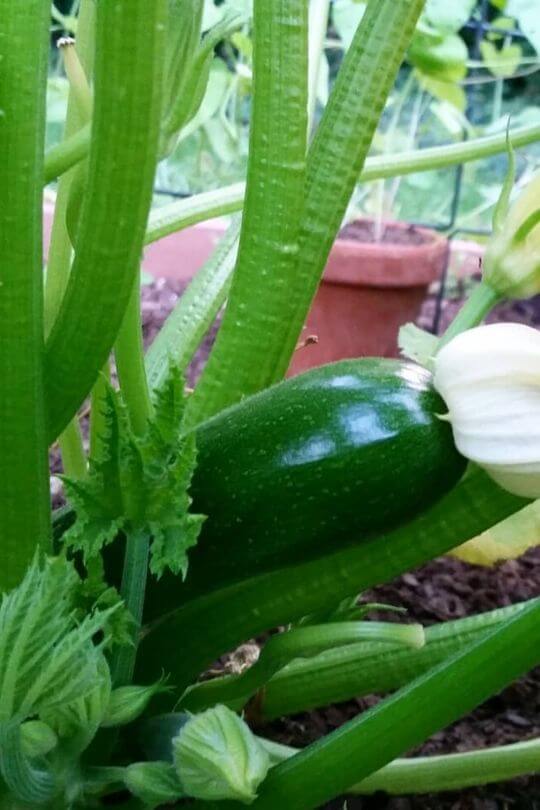
Emerald Delight developed as a compact zucchini with an open growing habit. That makes it easier to spot all of the squash rather than accidentally missing them and letting them get too large, which can happen too often.
One reason that you might like Emerland Delight is that it’s ready to harvest about one week earlier than other types, typically within 55 days.
This variety is resistant to powdery mildew, zucchini yellow mosaic virus, and watermelon mosaic virus 2.
5. Max’s Gold
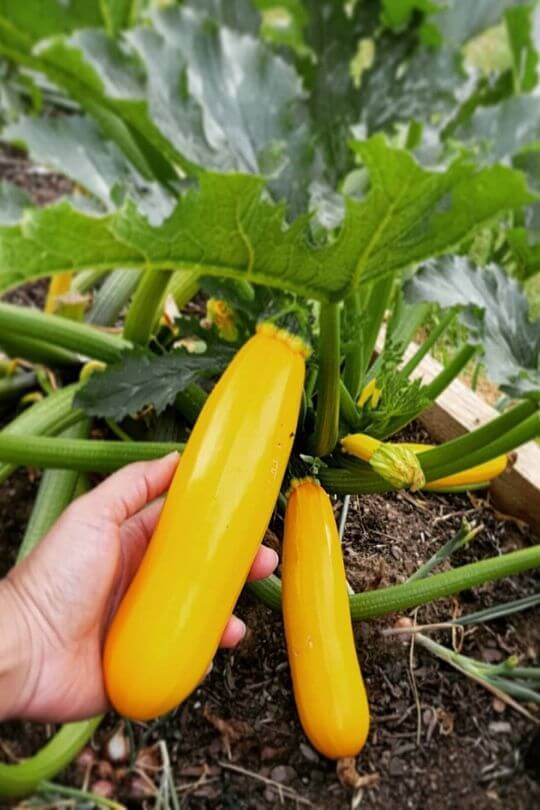
Last but not least, here is bushy-type zucchini lat that reaches 3 feet tall and 3-4 feet wide. It has a beautiful gold color on the outside.
Something we love about Max’s Gold is that it has a small seed cavity, so there is more flesh to eat. You can use this zucchini for grilling, salads, or fresh eating.
Final Thoughts
Just because you don’t have a lot of space to grow vegetables doesn’t mean you can’t grow zucchini. Growing zucchini in pots is a great idea! Even with their sprawling vines,
zucchinis love containers, and you’ll have a bountiful harvest at the end of the growing season. Everyone should be able to enjoy homegrown, fresh zucchini in the summertime.

Written By
Amber Noyes
Amber Noyes was born and raised in a suburban California town, San Mateo. She holds a master’s degree in horticulture from the University of California as well as a BS in Biology from the University of San Francisco. With experience working on an organic farm, water conservation research, farmers’ markets, and plant nursery, she understands what makes plants thrive and how we can better understand the connection between microclimate and plant health. When she’s not on the land, Amber loves informing people of new ideas/things related to gardening, especially organic gardening, houseplants, and growing plants in a small space.

Very enjoyable read. Helpful information for all gardeners, presented in an easy to read format. Nice.
Hi, is it possible to grow Costata Romanesco in a pot?
Absolutely! It is possible to grow Costata Romanesco, also known as Romanesco zucchini or Italian zucchini, in a pot. In fact, many vegetable varieties can be successfully grown in containers, including this delicious and unique zucchini variety.
When choosing a pot for your Costata Romanesco, opt for a container that is at least 12-16 inches (30-40 centimeters) deep and has a diameter of around 18 inches (45 centimeters) or larger. This will provide enough space for the roots to grow and allow the plant to thrive.